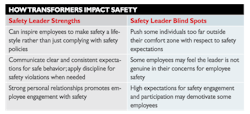How Leadership Styles Impact Employee Safety
Take a moment to think of the best people for whom you ever worked. What made each of them a good leader? It’s likely that you can think of more than one person, and they probably had some similarities, but also many differences in how they led you. That is because there are many different ways to lead people successfully.
Everyone develops a unique leadership style over time. Your style will depend on many factors, including personality traits, experience, values and the organizational culture in which you have worked. Over time, these shape the way in which we lead others.
Research has shown that our leadership style can be broken down into two distinct parts. These two parts generally can be described as:
- our focus on process, tasks and results; and
- our focus on people and relationships.
Think of these as two independent continuums, such that your leadership style could be high or low on both process and people. Depending on your level of process focus and your level of people focus, this will say a lot about your natural leadership style.
The process side of this equation emphasizes things such as meeting objectives and timelines. It ultimately centers on getting the job done in a timely, consistent and successful manner. Individuals who demonstrate a high level of process focus in their leadership tend to be direct in their communications, to like planning and organizing, and like to set clear guidelines and consequences for behaviors.
In contrast, people-focused leadership is really about just that—the people. The people focus factor is more about knowing and establishing deeper relationships with your team members, caring about their perceptions and feelings and maintaining morale. A key theme of this style essentially is "keeping my people happy."
1. Transacter
Transactional leaders, who have a high process and low people focus, tend to be autocratic and directive in their leadership style. As the name suggests, they view the leader-subordinate relationship as a transaction where rewards or negative consequences are contingent upon successfully meeting (or not meeting) specific goals. They are naturally comfortable creating clear boundaries between themselves and their team members.
Therefore, transacters tend to provide consistency and clear expectations, but also can be demanding and lack empathy, which hinders their ability to build strong relationships and engage with employees.
2. Transformer
Transformational leadership has been researched for decades and has been linked to many positive outcomes. Being naturally high on both people focus and process focus, this leadership style strikes a natural balance between looking out for people’s wellbeing and morale, while ensuring that goals and deadlines are met in a consistent manner. Leaders who naturally are high on process and people focus will find it easier to achieve this balance and inspire their direct reports to achieve success.
Transformers know how to motivate each individual, and know how to get the most out of their people while keeping them engaged. Their high standards can be demanding on some, and they are known for pushing people outside their comfort zone.
3. Relater
If you ever worked for someone who was more like a friend than a boss, then he or she likely was a relater. With a high people and low process focus, relaters care more about the person and their well-being than meeting goals or objectives. They are approachable and non-threatening, making it easy for their subordinates to work for them. Employees respond well to their supportive nature and genuine interest in them.
While this style has many benefits, individuals with this leadership style can struggle to set clear objectives for their direct reports, and often avoid difficult conversations about performance. As a result, some of their direct reports may take advantage of them, knowing they are unlikely to confront them or apply consequences for their performance.
4. Overseer
The overseer leadership style is very similar to laissez faire leadership, where a supervisor leads from afar and provides his/her subordinates with a high level of autonomy in how they perform their work. Being low on process focus, individuals with this leadership style are not highly structured or detailed in their planning and are "hands-off."
Leaders with this style place a high degree of trust in their subordinates and avoid micromanaging them. Because they also have a lower people focus, overseers also tend to be a bit detached from their subordinates in that they do not feel a strong need to know them on a personal basis or build strong relationships with them.
While most employees enjoy autonomy, overseers may be out of touch with their team’s activities and fail to provide clear expectations for performance.
Link Between Safety Leadership and Safety Outcomes
Studies have found that there is a relationship between leadership styles and leading indicators of safety such as safety climate (Barling, Loughlin & Kelloway, 2002), and safety participation behavior (Kapp, 2012). Furthermore, leadership styles shape general leader behaviors, which consistently impact both leading and lagging indicators of safety (Kelloway, Mullen & Francis; Zohar, 2003).
This can apply to injury metrics, too. In a study conducted in the energy industry by Select International, supervisors with an overseer and relater leadership style had significantly more first aid and recordable injuries on their respective crews than leaders with transactional and transformational leadership styles.
All four of these leadership styles bring many positive elements to workplace safety. However, each has its own set of potential blind spots that can increase exposure to risk, either indirectly or directly. It could be said that there is a time and place for each one of these styles, depending on the current situation. For example, the inherent level of risk in the work environment, recent safety incidents, organizational safety climate and the skills of the workforce each can determine which style might be best at the time.
While a leader can be coached on how to display effective leadership behaviors, he/she will possess certain stable personality traits, values and preferences that will lead them to default towards one of these styles. Like a crease in a page, a leader always will have a tendency to use one of these styles as a sort of default leadership mode, or comfort zone. Such a tendency is natural and need not be problematic.
What is important is that the leader be aware of these tendencies and how they impact the safety of their team members. Only then can they make meaningful changes in their leadership behavior that will systematically reduce the exposure to risk of their team members and their workplace.
Esteban Tristan, Ph.D., is the safety practice manager and a senior consultant at Select International. He manages the development and implementation of all safety solutions and services, which address some of the critical challenges faced by organizations today in workplace safety.




